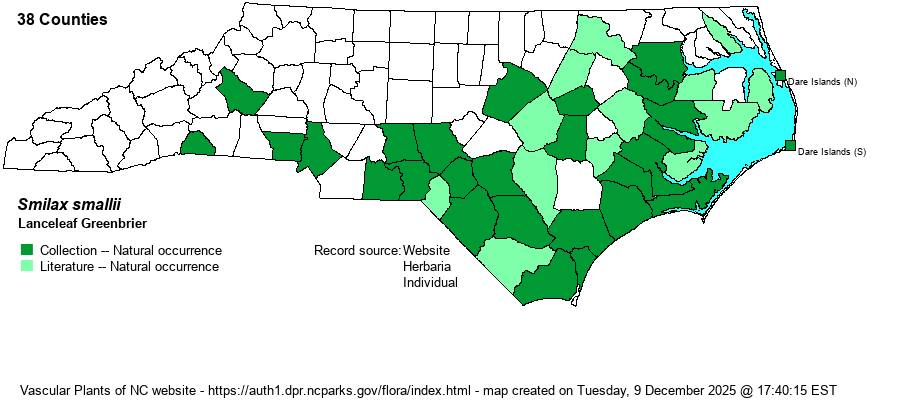| Author | Morong | |
| Distribution | Formerly primarily in the lower and southern Coastal Plain, with widely scattered records elsewhere in the Coastal Plain and the southern Piedmont. However, in recent years it has been spreading northward toward the VA border and inland to the eastern Piedmont. There are large numbers of photos in recent years on iNaturalist, despite relatively few recent specimens. As this species is used for ornamental purposes, some occurrences may pertain to escaped individuals/populations.
This is a Southern species that has apparently not yet been found in VA, ranging north to northeastern NC and southeastern OK, and south to central FL and eastern TX.
| |
| Abundance | Increasing in recent decades. Infrequent to fairly common north to mainland Dare and Bertie counties, and inland to about Cumberland and Robeson counties. Uncommon in the Sandhills, and rare to uncommon over the northern and northwestern portions of the province. Rare to uncommon in the southern Piedmont. Much less often encountered than S. glauca, S. laurifolia, and S. rotundifolia within its range. | |
| Habitat | This is primarily a plant of wetland forests and edges, but it can appear somewhat weedy. It is most often found growing with/on evergreen trees and shrubs in bay forests, bottomlands, floodplains, and drier swamps, more often seen along the margins of such forests than deep in the interior as many greenbriers do. |
| Phenology | Blooms in June and July; fruits mature the following April and May. | |
| Identification | This is a high-climbing, evergreen vine; however, it has slender stems that are usually unarmed. Though the leaves are certainly evergreen, they are flexible in texture. As a result, they make excellent Christmas decorations. The leaves are medium-sized for a Smilax, but slightly narrower, being elliptical to lanceolate and sharply pointed at the tip; the margins are entire and contain no serrations. As the berries do not ripen in the first fall or winter, one often sees whitish or pale green berries over the winter, later ripening to dull red or blackish. Though it really does not look like any other NC greenbrier, it is not as well known as it should be, in part because it is not overly common and because it frequently grows on other evergreen vegetation, easily passed over as S. rotundifolia or S. laurifolia or simply not noticed at all. | |
| Taxonomic Comments | Weakley (2018) states: “Unless the name S. smallii is conserved, it must be replaced by the older S. maritima”.
| |
| Other Common Name(s) | Small’s Greenbrier, Jackson-brier, Jackson-vine, Southern Smilax | |
| State Rank | S4 | |
| Global Rank | G5? | |
| State Status | | |
| US Status | | |
| USACE-agcp | FACU link |
| USACE-emp | FACU link |

